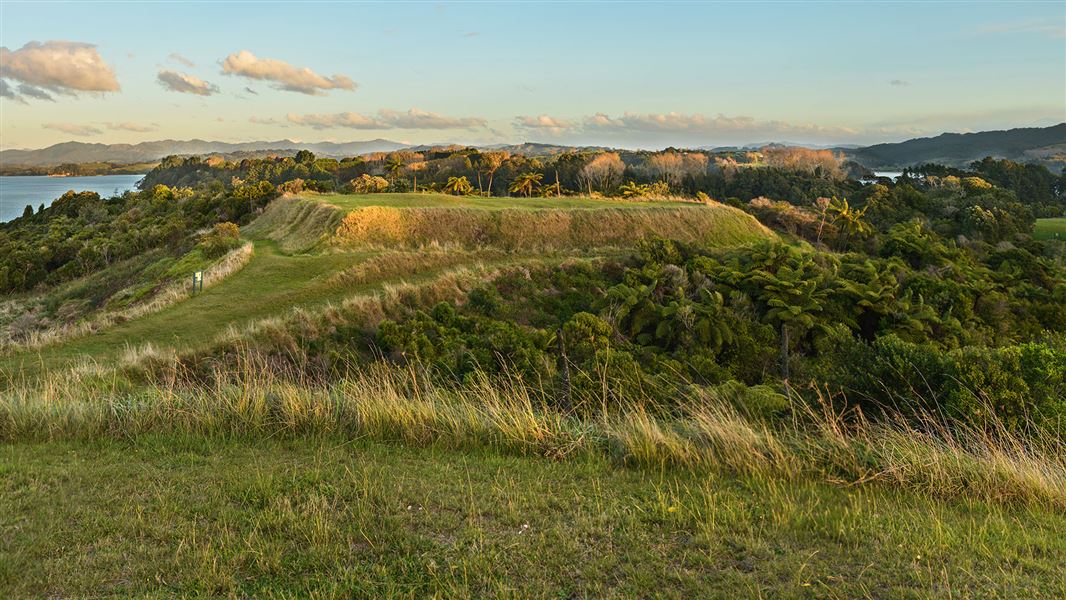
Introduction
Tauwhare Pā Scenic Reserve is one of the oldest pā sites in the Bay of Plenty. This pā is a snapshot in time on how the first Māori settlers, Te Hapūoneone, once lived.Tauwhare Pā has close ancestral ties to Ngāti Awa, the current guardians of the land. There are panoramic views from the pā: on clear days, Whakaari/White Island is visible, as well as Ohakana Island, Port Ōhope and the East Cape.
Visitors to the pā will enjoy the wide variety of native plants and animals, including a thriving pōhutukawa forest, tūī and kererū. Ōhiwa Bay, overseen by Tauwhare Pā, is an important breeding ground for sharks, as described in a traditional whakataukī/proverb:
E noho ana anō ahau ki te koko ki Ōhiwa,
Whakarongo rua aku taringa ki te tai ō tua rā ō Kanewa
E aki mai ana ki uta rā ki te whānau ā Tairongo
Kei Tauwhare, ko te kōpua ō te ururoa
Ko te kai rā i rari noa mai te rawaweketia e te ringaringa
As I reside in the Bay of Ōhiwa
I hear the call of the tide at Kanewa
Urging me to join the clan of Tairongo
At Tauwhare is the dwelling place of shark
The abundant food that has been disturbed by the hand of man
Tauwhare Pā is split into three distinct sections, the best preserved of which are known as the northern and southern platforms. These wide, flat platforms sit high above the surrounding landscape, granting Tauwhare the name “village suspended in space”.
Getting there
Tauwhare Pā Scenic Reserve is near Ōhope in the Eastern Bay of Plenty. Follow the Pacific Coast Highway south out of Ōhope for 1.4 km, before pulling into the signposted car park. There is a short walk through lush forest up to the pā.
Vehicle access on to the reserve is strictly prohibited for safety reasons. Use the car park instead
Early settlement
The early migratory Rangimatoru waka was captained by Hape-ki-tu-manui-o-te-rangi, who landed the waka in Ōhiwa Harbour. Hape’s ancestral tribe Te Hapūoneone, led by the peaceable Tama-ki-Hikurangi, were the first known residents of Tauwhare Pā. Over many years they were assimilated by the descendants of Awanuiarangi, who later became Ngati Awa.
A symbol of unity
In 1847, the chief of Tauwhare was Te Keepa Toihau of Ngāti Awa. His daughter, Mere Aira, had a child with neighbouring Whakatōhea chief Kape Tautini. When Whakatōhea laid siege to the pā site, intending to drive Ngāti Awa away before they became too powerful, Mere Aira raised the child Te Pirini Tautini above her head and declared him a symbol of the two tribes. The gesture moved the two tribes to peace, and the pā has not been a site of conflict since.
Becoming a reserve
Tauwhare Pā was privately purchased in the 1950s and land for a subdivision was cleared, but never finished. The land was instead used for livestock farming until Crown purchase in 1980. The pā was identified as a heritage site in 1988, and the Tauwhare Pā Scenic Reserve was opened soon after.